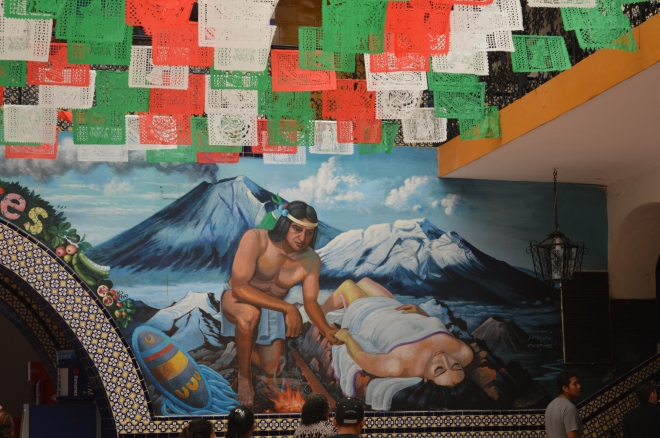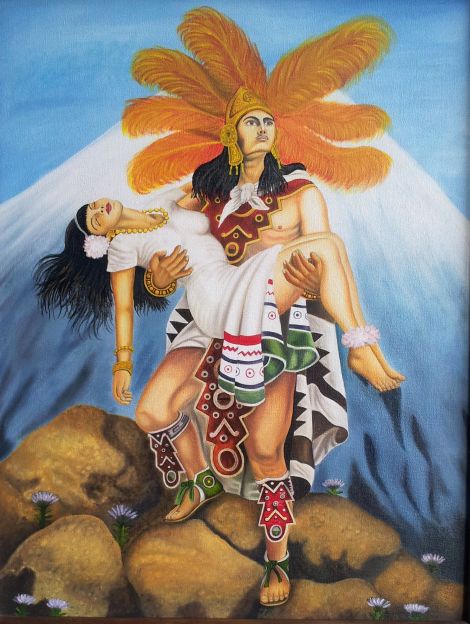
Popocatepetl and Iztaccihuatl By AlejandroLinaresGarcia (Own work) [CC BY-SA 4.0 (http://creativecommons.org/licenses/by-sa/4.0)%5D, via Wikimedia Commons
The Aztec empire began as Triple Alliance of city states in the Valley of Mexico. These city states were Tenochtitlan, Texcoco, and Tlacopan with Tenochtitlan eventually becoming the dominant military power. The Valley of Mexico is surrounded by mountains and volcanoes that are part of the Trans-Mexican Volcanic Belt. Naturally, with such dominant and dramatic features in the landscape the volcanoes became the subject of many myths and legends and the following two folktales give accounts of how the volcanoes Popocatepetl and Iztaccíhuatl originated and were named.
Princess Iztaccihuatl and Popocatepetl
The first tells how the Aztec Emperor had a daughter named Princess Iztaccihuatl who was a very attractive woman. Her beauty and her social position as the emperor’s daughter encouraged many rich and powerful men to seek her hand in marriage. Although she was spoilt for choice her favourite and the one she gave her heart to was an Aztec warrior named Popocatepetl and he in return gave his to her.
As is often the case the rulers of empires and nations need to impose taxes on their citizens and subjective people to pay for state functions, services and for many other reasons. Unfortunately taxes are never popular with those who have to pay them and the Aztec taxes were particularly oppressive. One of the victims of these taxes were the Tlaxcaltecas people who had no love for the Aztecs in the first place and they rebelled refusing to pay.
The Emperor decided that he would send his army to put down the Tlaxcaltecas rebellion and Popocatepetl was chosen to lead it. Before he left for war Popocatepetl asked the emperor his permission to wed his daughter. The Emperor agreed but only if Popocatepetl returned victorious and only then would there be a big wedding and celebration.
Popocatepetl readily agreed and prepared the army for war. Before he left he promised Princess Iztaccihuatl that he would return victorious and there would be a great wedding and victory celebration. Princess Iztaccihuatl did not want him to go to war but she agreed to keep herself for him until the day of his return when they would consummate their love. Popocatepetl kept this promise safe, deep within his heart looking forward to the day of his return.
Popocatepetl had many rivals who were jealous of his prowess as a warrior and for his place in the heart of Princess Iztaccihuatl and one of these was named Tlaxcala. One day while the war was being fought Tlaxcala went to her and told her that Popocatepetl had been killed in battle. Naturally, Princess Iztaccihuatl could not imagine that anyone would tell such a terrible lie and believed him. Devastated with grief for the loss of her loved one she could not eat or drink thereafter and slowly wasted away and died.
Meanwhile, the war with the Tlaxcaltecas people was proving to be a long and bloody campaign. Although Popocatepetl led his warriors bravely and skilfully it took a long time to subdue the rebellion and no news came to him of the tragic death of his beloved. Eventually, he gained victory and returned in triumph looking forward to his marriage to Princess Iztaccihuatl and to consummate his love with her. When her father told him of her terrible death he was overcome with grief. Darkness fell upon him and he went from the palace and wandered through the streets in black despair for several days. At last he decided he would do something to honour her and make sure the memory of her would last forever and vowed to create an eternal monument to her.
He piled ten hills on top of each other to create one huge mountain that rested under the sun. Then tenderly lifting the body of the princess he carried her up the mountain and gently laid her down. He bent and kissed her lips then raised a torch and knelt before his love keeping an undying watch over her everlasting slumber. There the two lovers became transformed through the ages into two magnificent volcanoes that look out over Mexico City today and this is how Popocatepetl and Iztaccihuatl will remain until world’s end and the final judgement is cast.
According to the legend there are times when Popocatepetl yearns to hold his beloved again. They say his heart still carries the eternal passion he held for her and every now and then it bursts free with smoke and flame. The legend also tells how the liar Tlaxcala repented of his evil deed and wandered off and died nearby. Over time his body became the volcano called Pico de Orizaba who now watches from afar the dreaming of Popocatepetl and Iztaccihuatl, knowing they can never again be separated.

Popocatepetl and Iztaccihuatl By AntoFran (Own work) [CC BY-SA 3.0 (http://creativecommons.org/licenses/by-sa/3.0)%5D, via Wikimedia Commons
The Náhuas Legend
Probably the best known version of the story of Popocatepetl and Iztaccihuatl is the Nahuas legend. This tells that many years before the arrival of Cortes and his Spanish conquistadores there was once an Aztec Emperor who was much loved by all of his people. The Emperor and his wife had no children and they desperately wanted a baby and so did the people so that their line would continue. One day with joy in her eyes the empress went to see her husband and told him that she was with child. The Emperor was overjoyed and in due course his wife gave birth to a beautiful baby girl. The happy couple named their daughter Iztaccíhuatl which in their language meant white lady. The people were also delighted with her birth and loved her greatly.
As she grew up Iztaccíhuatl was taught all of the things that were appropriate, important and necessary for a daughter of the Aztec rulers to learn. In this way her parents prepared her to rule when they had passed on. Being young and beautiful and an Aztec princess she had many suitors but she fell in love with a young warrior chief of her people named Popocatepetl.
One day Popocatepetl was sent to fight a war by the Emperor who promised him that if he could bring back the head of his enemy he would give him permission to marry Iztaccihuatl. Popocatepetl vowed he would do this and motivated by the thought of marriage to Iztaccihuatl went off to war. The war turned out to be a long and bloody struggle that was waged for several months. One of his rivals sent a message to the emperor saying that Popocatepetl had been killed in battle. When the Emperor told Iztaccihuatl she became inconsolable with grief and sorrow and fell into a black depression. She spent days on end crying and would not eat or drink and eventually died of broken heart.
However, Popocatepetl was still very much alive and eventually triumphed and returned to the emperor with his enemy’s head in triumph expecting to marry Iztaccihuatl. He was shocked to find that the funeral of Iztaccihuatl was underway and when the Emperor told him that she had died after being told by another warrior of his supposed death, he was devastated.
Popocatepetl took the body of Iztaccihuatl and carried it for many miles and then ordered his warriors to build a funeral table for her to rest upon. This was done and the table was decorated with many beautiful flowers and Popocatepetl gently laid the body of his love upon the table. Then he kneeled over the body to watch over her and he died in that position. The Gods looked down and were moved by the dedication of Popocatepetl and turned the two bodies into huge volcanoes. The largest of these is Popocatepetl whose name in Náhuatl means smoking mountain. Sometimes even today smoke can be seen issuing from him which is said to prove that the fire he had for Iztaccíhuatl still survives.
© 10/01/2018 zteve t evans
References, Attributions and Further Reading
Copyright January 10th, 2018 zteve t evans
- Popocatépetl and Iztaccíhuatl – Wikipedia
- he Legend of Popocatepetl & Iztaccíhuatl A Love Story
- The Legend of Popocatepetl and Iztaccihuatl – Mexico’s Volcanes .
- Tlaxcaltec – Wikipedia
- Popocatepetl and Iztaccihuatl By AlejandroLinaresGarcia (Own work) [CC BY-SA 4.0 (http://creativecommons.org/licenses/by-sa/4.0)], via Wikimedia Commons
- Popocatepetl and Iztaccihuatl By AntoFran (Own work) [CC BY-SA 3.0 (http://creativecommons.org/licenses/by-sa/3.0)], via Wikimedia Commons
